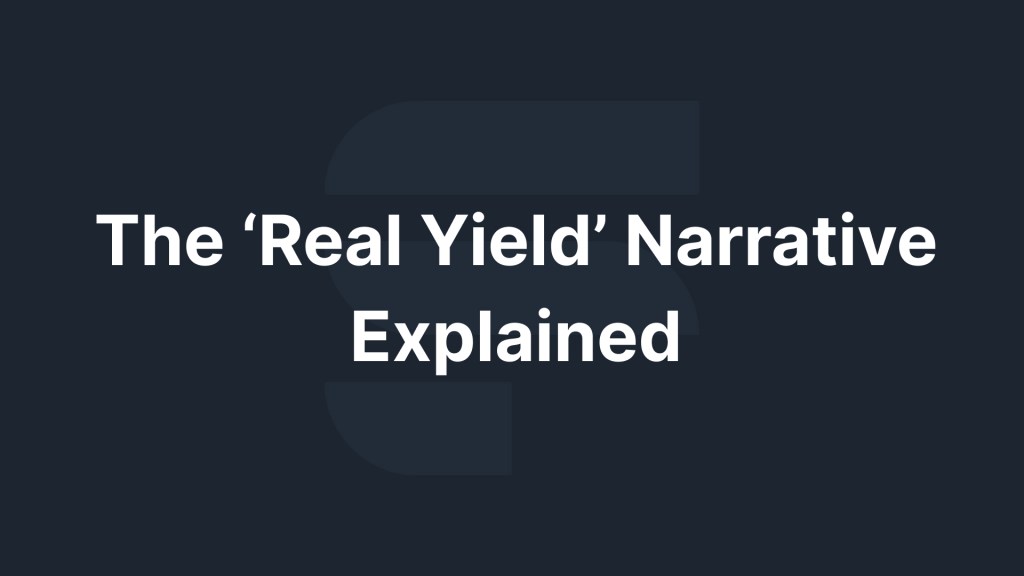General
The ‘Real-yield’ Narrative Explained
Mar 22, 2023

Profitability is a critical factor in decentralized finance (DeFi), as it governs the incentives and rewards for utilizing or staking within a protocol. Within DeFi communities, the concept of "real-yield" is gaining traction as users aim to optimize their returns and mitigate the eroding impacts of inflation. This piece will examine the various types and origins of yields, as well as the notion of real yield and its relevance in DeFi protocols.
Real Yield vs. Inflationary Yield
Unsustainable vs. Sustainable Yield
Sources of Yield
DEXs
Lending Protocols
Conclusion
Real Yield vs. Inflationary Yield
Real yields in DeFi are a result of a strong product-market fit and sustained usage. When a DeFi protocol provides value to its users and they continue to use it over a long period of time, it generates fees for the protocol, which translates to real yield for its users. Therefore, protocols need to prioritize creating valuable products and incentivizing sustainable usage to maximize real yields for their users.
On the other hand, inflationary yields arise from the emission of governance tokens. Token emissions are used to incentivize participation and voting within the community. However, the emission of these tokens can lead to inflation, which can reduce the token's value over time. It's important to note that high inflation rates don't necessarily guarantee high yields for users. The value of the token may decrease faster than the yield generated. Therefore, it's crucial to target protocols with a balance between emission inflation and real yield to maximize profits.
Overall, token emissions are a powerful tool that protocols can use to incentivize user participation and drive growth, but they must be used responsibly to avoid negative impacts on the ecosystem.
When choosing a protocol to stake or farm, it is important to consider the type of yield that is being offered. Inflationary yield may seem attractive, but it is not always sustainable in the long run. It is advisable to target protocols that offer a balance between emission inflation and real yield. In addition, it is important to choose protocols with high usage and trading volumes to maximize real yield.
Unsustainable vs. Sustainable Yield
Unsustainable yields are characterized by high returns that are not supported by the underlying fundamentals of the project but rather stem from unsustainable sources, such as token emissions or yield farming incentives. These yields are typically short-lived, accompanied by high levels of volatility and risk.
For instance, a decentralized exchange or lending protocol that generates revenue from transaction fees or interest on loans would generate sustainable yields. Investors should exercise caution when dealing with unsustainable yields and instead focus on sustainable ones. While unsustainable yields may be alluring in the short term, they often involve a high level of risk and are not sustainable over the long run. In contrast, sustainable yields can offer investors a more stable and predictable return over time.
Sources of Yield
Decentralized Exchanges (DEXs) and lending protocols are the two major sources of yield in the DeFi ecosystem.
DEXs
Decentralized Exchanges (DEXs) are platforms that facilitate the exchange of tokens in a decentralized manner. DEXs generate yields from trading fees, which they then use to reward and incentivize liquidity providers (LPs).
Liquidity providers (LPs) deposit two tokens into a liquidity pool, and they receive LP tokens that represent their share of the pool. These LP tokens will accrue value in relation to the pool, and can also be staked on yield farming platforms to earn additional rewards (governance token emissions aka inflationary yield).
Some of the popular DEXs in the market are Uniswap, Sushiswap, and Curve.
Lending Protocols
Lending protocols, on the other hand, allow users to lend or borrow cryptocurrencies without the need for a centralized intermediary. These protocols generate yields from the interest charged on borrowed funds from overcollateralized positions.
Users can lend their cryptocurrencies to earn interest, or they can borrow funds by depositing collateral. The interest rates for lending and borrowing are determined by the market demand and supply for the specific cryptocurrency.
Some of the popular lending protocols in the market are Compound, Aave, and MakerDAO.
Conclusion
In conclusion, the profitability of DeFi protocols is a crucial factor that governs the incentives and rewards for users. With the concept of "real-yield" gaining traction in DeFi communities, it is important to understand the different types and sources of yields, including those generated from DEXs and lending protocols.
Furthermore, the distinction between real yield and inflationary yield is critical, as it highlights the importance of sustainable usage and product-market fit in generating long-term yields. Investors should exercise caution when dealing with unsustainable yields and instead focus on sustainable ones, which offer a more stable and predictable return over time. Overall, a balanced approach is necessary when evaluating the various DeFi protocols and their associated yields.
To learn more, visit blog.streamflow.finance/